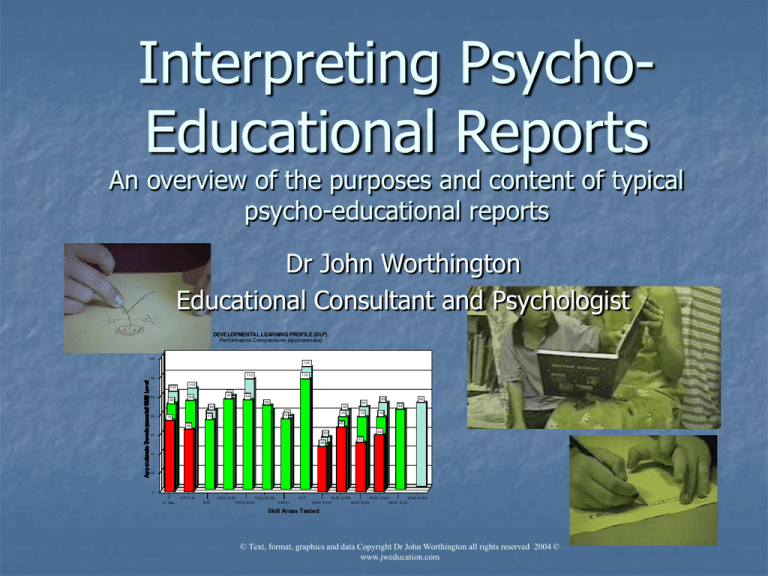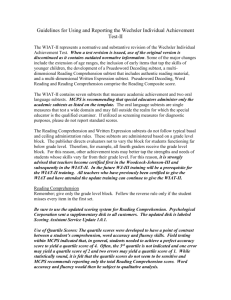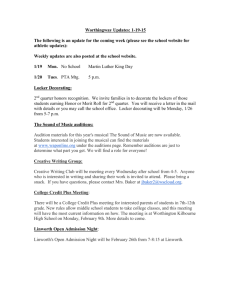
Interpreting PsychoEducational Reports
An overview of the purposes and content of typical
psycho-educational reports
Dr John Worthington
Educational Consultant and Psychologist
DEVELOPMENTAL LEARNING PROFILE (DLP)
Performance Comparisons (approximate)
140
126
113
120
100
100
90
103
95
95
93
80
80
116
73
75
94
88
88
80
84
74
74
76
76
88
84
80
76
68
66
60
52
60
48
48
52
40
20
0
P PV T-II I
C. Age
E VT
TA CL-R S I
TA CL-R S II I
TA CL-R S II
V MI -I V
TV P
WI AT -II WR
WI AT -II NO
WI AT -II M R
WI AT -II P D
WI AT -II S p
WI AT -II LC
Skill Areas Tested
© Text, format, graphics and data Copyright Dr John Worthington all rights reserved 2004 ©
www.jweducation.com
Aims of the Presentation
What is a psycho-educational report / assessment?
What elements should we first consider the report? (the who, when, where,
what, why and how of the process).
What is the typical structure of a ‘good’ psycho-educational report?
To refresh our understanding of the strengths and limitations of intellectual
assessment tools
To take an overview of the WISC-IV, its structure and its use in identifying
and supporting individuals with learning disability
Presenting different results in a Developmental Learning Profile (DLP)
© Text, format, graphics and data Copyright Dr John Worthington all rights reserved 2004 ©
www.jweducation.com
Just a Reminder of what learning
disability looks like?
(Learning Disability in the younger child)
Significant History: A general parental
concern prior to or shortly after the start
of formal schooling. Little or no interest
by the child in play reading or writing but
may like being read to. Slow to take on
and have an interest in letters (names
and or sounds) and may struggle to
distinguish between digits and letters,
and does not notice differenced in letter
orientation d/b/p/q etc.
Figure 1. Spelling / writing sample of
five year girl with possible (future)
Learning Disability.
© Text, format, graphics and data Copyright Dr John Worthington all rights reserved 2004 ©
www.jweducation.com
What is a psycho-educational
assessment?
Essentially psychological assessment involves testing the ‘mind’ usually ‘cognitive’
functioning, the ability of the mind to do certain things. Typically this means testing
intelligence but assessment may also be focused on functions such as auditory or
visual memory, short term memory and or working memory.
The educational part usually refers to academic skills (e.g. reading comprehension,
spelling, mathematics etc.) but often also includes elements of language skills (e.g.
receptive vocabulary), fine motor skills and visual perception. Many skills especially in
younger children such as phonemic awareness, fine motor and visual perception
skills, sit within both the educational and therapy models and sometimes in the
psychological model.
Clinical psychologist also do assessments involving higher level (executive)
functioning, personality types, ‘assessments’ of psychological disorders (e.g. OCD,
personality disorders, conduct disorders etc.)
© Text, format, graphics and data Copyright Dr John Worthington all rights reserved 2004 ©
www.jweducation.com
What elements should we look for
in first considering the report?
While it might sound a little trite, psych-educational reports should be in
writing. My experience and reading makes it very clear oral reports by
parents and others, of psycho-educational assessments are not reliable.
This is because even in ideal circumstances parents are under stress when
listening to results, they can be selective about what they ‘choose’ to
remember and they are likely to forget and or confuse detail.
Check the report is actually about the child your are interested in (check at
least the full name and date of birth). How old in the information? check
when the assessment was done (DOA) and the date the report was written
and signed as sometimes there is a long gap.
The written report should be complete (numbered pages with no missing
pages or missing attached sheets), signed by the responsible professional
with their ‘title’ / position clearly indicated.
© Text, format, graphics and data Copyright Dr John Worthington all rights reserved 2004 ©
www.jweducation.com
What elements should we look for
in first considering the report?
(continued)
Make sure you have received the report in an ‘ethical’ way and that you
have an appropriate professional reason for reading it.
Check why the report written and the reasons leading to the assessment /
referral.
Look at the reasons for the assessment and look for the process that was
followed. This may parallel your need for understanding the child or be
completely different.
Remember psychological assessment is as much an art as a science the
precautionary notes and confidence intervals need to be considered.
Remember you don’t have an exact IQ you have a score representing
performance within a confidence range.
© Text, format, graphics and data Copyright Dr John Worthington all rights reserved 2004 ©
www.jweducation.com
What is the typical structure of a
‘good’ psycho-educational report?
Essentially a ‘good’ psycho-educational report should present as a
structured story.
The report should initially identify the person who wrote the report and the
person about whom the report was written (full name and DOB). There
should be additional sufficient information to allow the reader to know the
physical and professional source and how that place and organization can
be contacted.
After the identification there should be an introduction outlining the reasons
the report was written and its purpose.
There there should be a concise description of the process (of assessment),
the results and the conclusions.
© Text, format, graphics and data Copyright Dr John Worthington all rights reserved 2004 ©
www.jweducation.com
Interpreting Psycho-Educational
Reports the Detail
Essentially psycho-educational reports summarize the results of
assessments typically standardized assessments. They should have an
introduction (often with a history) and details of any special features or
issues influencing the assessment and or the results.
There may also be detailed of different types of ‘observations’ of behaviour
and functioning.
Psycho-educational reports may link the psychological results (QI =
potential to learn academically) to academic results. Some reports may also
go on to identify which specific elements of the IQ testing (usually at the
subtest level) that are implicated in learning issues or learning styles.
© Text, format, graphics and data Copyright Dr John Worthington all rights reserved 2004 ©
www.jweducation.com
What is standardized assessment?
Standardized assessment forms one part of gaining an understanding of an
individuals functioning in one or more areas of ability, skills an behaviour.
Standardized test are highly structured instruments which allow the
observation of an individuals’ performance. The ‘result’ achieved is then
compared to the performance of a group judged to represent the
population (from which that individual has come).
The standardized test is the is the mainstay of the psycho-educational
assessment process along with an analysis of the history (including previous
assessments and reports) and clinical observations.
© Text, format, graphics and data Copyright Dr John Worthington all rights reserved 2004 ©
www.jweducation.com
Some Assessment instruments focusing
on cognitive functioning
Wechsler Preschool and Primary Scale of Intelligence – Third Edition
Australian Standardisation (WPPSI-III) (Wechsler, 2004) (2y 6m to 3y 11m;
4y 0m to 7y 3m)
Wechsler Intelligence Scale for Children - Fourth Edition (WISC-IV) Australian
Language Adaptation (Wechsler, 2003) (6y-16y 11m)
Wechsler Adult Intelligence Scale-Third Edition (WAIS-III) (Wechsler, 1997)
(16y-89y)
Kaufman Brief Intelligence Test, (K-BIT) Australian Language Adaptation
(Kaufman & Kaufman, 1996)
Slosson Intelligence Test - Revised (SIT-R3) (Nicholson & Hibpshman, 2002)
© Text, format, graphics and data Copyright Dr John Worthington all rights reserved 2004 ©
www.jweducation.com
Wechsler Intelligence Scale for Children Fourth Edition (WISC-IV) (Australian
Language Adaptation) (Wechsler, 2003)
The WISC-IV is an individually administered instrument for assessing the
cognitive ability of children aged 6y 0m to 16y 11m. The WISC-IV has
resulted from a significant revision of the WISC-III (Wechsler, 1992). The
WISC-IV has ten subtests and five supplemental subtests and the results
provide subtest and composite scores that represent intellectual functioning
in four specific cognitive domains, as well as a composite that represents
general intellectual ability (i.e. Full Scale IQ) (Wechsler, 2003).
The WISC-IV and its sister tests the WPPSI-III and the WAIS-IV represent
the current generation of IQ tests typically in the American tradition. There
are other types of tests and other families of tests which typically evolve
over time. This evolution is driven by research and cognitive theory and the
fact that over time specific elements in tests become either ‘easier’ or
outdated.
© Text, format, graphics and data Copyright Dr John Worthington all rights reserved 2004 ©
www.jweducation.com
WISC-IV Presentation of the results
Full Scale IQ Standard Score (Mean 100 SD 15); Four Index Standard
Scores (Mean 100 SD 15) and Subtest Scaled Scores (Mean 10 SD 3)
All levels of results can be reported in percentile ranks (%ile) while the
subtest results can also be reported in Age Equivalents
Remember the confidence intervals are important especially near the ‘ends’
of particular classifications
In this new generation of tests certain requirements need to be met before
a FSIQ can be calculated
Most QI tests now have computer programs which ‘write’ most of the report
in a split second. While such reports are likely to be relatively more accurate
in terms of scoring they can lack a practical specificity in the detail, be long
and full of precautionary statements. The report should state clearly if such
a tool has been used in full or in part
© Text, format, graphics and data Copyright Dr John Worthington all rights reserved 2004 ©
www.jweducation.com
Reading the Results
The test manual provides qualitative descriptions for the WISC-IV Full Scale
Scores which include "Very Superior 130 and above, “Superior” 120-129,
“High Average” 110-119; “Average” 90-109 and “Low Average” 80-89,
“Borderline” 70-79 and "Extremely Low" 69 and below.
The subtest scaled scores for an individual's same age peers have a metric
mean of 10 and a SD (i.e. standard deviation) of 3. Thus scaled scores of 7
(16 %ile) and 13 (84 %ile) are 1 SD below and above the mean
respectively, while scaled scores 4 (2 %ile) and 16 (98 %ile) are 2 SD's
below and above the mean respectively.
© Text, format, graphics and data Copyright Dr John Worthington all rights reserved 2004 ©
www.jweducation.com
The structure of the WISC-IV
The WISC-IV has four specific cognitive domains (Indexes) which together
contribute to the Full Scale IQ
FULL Scale IQ
Verbal
Comprehension
Perceptual
Reasoning
Working
Memory
Processing
Speed
© Text, format, graphics and data Copyright Dr John Worthington all rights reserved 2004 ©
www.jweducation.com
The structure of the WISC-IV
Each of the four Index scores is derived from a number of subtest scores.
There are five supplemental subtests which can be substituted for a specified
number of core subtests if needed.
WISC-IV Full Scale IQ
Verbal Comprehension
Index
Perceptual Reasoning
Index
SI
BD
VC
CO
PCn
MR
Working Memory
Index
DS
LN
© Text, format, graphics and data Copyright Dr John Worthington all rights reserved 2004 ©
www.jweducation.com
Processing Speed
Index
CD
SS
Verbal Comprehension Subtests
SIMILARITIES (SI)
Individuals are presented with two words that represent common objects or
concepts and asked to say how they are similar.
VOCABULARY (VC)
Younger individuals are shown pictures and asked to name them. Then
individuals are asked to give definitions for words presented orally and
visually.
COMPREHENSION (CO)
Individuals are asked to respond to questions requiring an understanding of
social situations, reflecting common sense, social judgment, behaviour and
conventional standards.
INFORMATION (IN) (Supplemental subtest)
Individuals answer questions that address a broad range of general
knowledge topics.
WORD REASONING (WR) (Supplemental subtest)
Individuals are asked to identify the common concept
described in a series of clues.
© Text, format, graphics and data Copyright Dr John Worthington all rights reserved 2004 ©
www.jweducation.com
Perceptual Reasoning Subtests
BLOCK DESIGN (BD)
Individuals use up to nine red and white blocks to re-create a model or a
picture of a design within a specific time limit.
PICTURE CONCEPTS (PCn)
The individual is presented with two or three rows of pictures and choose
one picture from each row with common characteristics.
MATRIX REASONING (MR)
Individuals look at an incomplete matrix (made up of pictures or designs)
and selects the missing item from five options.
PICTURE COMPLETION (PCm) (Supplemental subtest)
Individuals have to point to or name an important part missing from a
picture within a specific time.
© Text, format, graphics and data Copyright Dr John Worthington all rights reserved 2004 ©
www.jweducation.com
Working Memory Subtests
DIGIT SPAN (DS)
Digit Span requires the individual to do two distinct tasks, the first
repeat orally numbers presented in the same order. Then the individual
is asked to repeat orally presented numbers in reverse order.
LETTER-NUMBERING SEQUENCING (LN)
Individuals are read a sequence of numbers and letters and are asked to
recall the numbers in ascending order and the letters in alphabetical order.
ARITHMETIC (AR) (Supplemental subtest)
Individuals solve a series of orally presented arithmetic problems within a
specific time limit.
© Text, format, graphics and data Copyright Dr John Worthington all rights reserved 2004 ©
www.jweducation.com
Processing Speed Subtests
CODING (CD)
Individuals copy symbols that are paired with simple
geometric shapes or numbers within a specific time limit.
SYMBOL SEARCH (SS)
Individuals scan a search group (of abstract symbols) and
indicate if a target symbol/s matches any of the symbols in
the search group within a specific time limit.
CANCELLATION (CA) (Supplemental subtest)
Individuals scan both a random and structured arrangement of
pictures and marks target pictures within a specific time limit.
© Text, format, graphics and data Copyright Dr John Worthington all rights reserved 2004 ©
www.jweducation.com
Understanding the WISC-IV Subtests
Now the structure of the WISC-IV is clear it is time to consider how to
‘understand’ what the results are saying about an individuals overall
learning potential (FSIQ), different areas of cognitive ability (Index Scores)
and specific areas of functioning (Subtests).
As interpretation moves from the FSIQ to the subtest level the more specific
the observation but the less reliable that specific performance (on a
subtest) on a specific occasion will be.
The test manual provides numerous ways to compare and contrast an
individuals performance at the Index and subtest levels. Such advanced
analysis can be useful when there is a high (or even a significant) degree of
variation between specific scores at particular level.
© Text, format, graphics and data Copyright Dr John Worthington all rights reserved 2004 ©
www.jweducation.com
WISC-IV Subtests (The fine detail)
Children with learning delays will usually have an unusual (read variable)
subtest profile, the overall result (FSIQ) will be the first clue, the Index
scores the next and the subtest results the final evidence.
From my experience the Working Memory Index and the Processing Speed
Index scores are often implicated in learning difficulties (dyslexic) profiles.
Within Working Memory the differences between digits forwards, digits
reversed and letter numbering sequencing needs close examination. The
Processing Speed can identify children who are referred for ‘not being able
to get their ideas down’.
Remember that while instruments like the WISC-IV can be a source of
valuable information about an individuals cognition and to a lesser extent
learning style, IQ tests are not designed to identify dyslexia or diagnose
general or specific learning difficulties. They are tests of cognitive
functioning and any link between any part of a WISC-IV ‘result’ and a
learning issue needs careful consideration.
© Text, format, graphics and data Copyright Dr John Worthington all rights reserved 2004 ©
www.jweducation.com
WISC-IV / WPPSI-III /WAIS-III
and the WIAT-II
There are tests of academic skills which can provide a direct relationship
between measured intelligence (QI) (seen as a good measure of the
potential to learn academic skills) and academic attainments (academic
skills).
Comparisons between ‘predicted’ learning levels and measured learning
levels now provides an additional tool to measure and understand delays in
specific learning and to track learning over time and relative to measured
ability.
© Text, format, graphics and data Copyright Dr John Worthington all rights reserved 2004 ©
www.jweducation.com
Profiling Results
The Developmental Learning Profile
(DLP)
In describing and ‘reading’ the patterns of results from different types of
assessments it is possible in an approximate way to present an overall
picture by plotting scores which are on the same scale.
In my practice by way of summarizing results I use age equivalent scores
and present them with ‘predicted scores’.
These DLP’s can be used to help diagnose different types of learning delays
(or acceleration) and over time combined as one way of tracking a child’s
learning development.
Learning Disability in the younger child
DEVELOPMENTAL LEARNING PROFILE (DLP)
Performance Compari sons (approximate)
100
85
80
84
77
70
72
72
68
66
61
60
60
60
57
48
40
20
0
SIT-R3
C. Age
EVT
PPVT-III
TACL-R SII
VMI-IV
TACL-R SI
TACL-R SIII
TVP
WIAT-II LC
WIAT-II MR
WIAT-II WR
WIAT-II NO
Skill Areas Tested
Figure 1. Developmental Learning Profile of 5 year girl with indications of Learning Disability.
© Text, format, graphics and data Copyright Dr John Worthington all rights reserved 2004 ©
www.jweducation.com
L D in middle and high school
DEVELOPMENTAL LEARNING PROFILE (DLP)
Performance Compari sons (approximate)
160
155
146
142
140
135
127
129
120
120
117
107
116
108
104
104
100
91
80
68
60
40
20
0
K-BIT Vocab
PPVT-III
TACL-R SI+
TACL-R SIII
C. Age
K-BIT Matrices
EVT
TACL-R SII
VMI-IV
TVP
WIAT-II WR
WIAT-II Sp
WIAT-II PD
WIAT-II RC
WIAT-II NO
Skill Areas Tested
Figure 2. Developmental Learning Profile of 12 year 2 months old boy with evidence of Learning
Disability.
© Text, format, graphics and data Copyright Dr John Worthington all rights reserved 2004 ©
www.jweducation.com
The learning disabled adult
DEVELOPMENTAL LEARNING PROFILE (DLP)
Performanc e Comparisons (approx imate)
300
269
250
200
150
134
100
100
105
107
108
110
116
116
107
96
84
96
88
50
0
K-BIT Matrices
EVT
TACL-R SII
VMI-IV
C. Age
PPVT-III
TACL-R SI+
TACL-R SIII+
TVP
WIAT-II PD
WIAT-II RC
WIAT-II MR
WIAT-II WR
WIAT-II Sp
Skill Areas Tested
Figure 3. Developmental Learning Profile of woman aged 22 year 5month showing consequences
of mild intellectual impairment and Learning Disability
© Text, format, graphics and data Copyright Dr John Worthington all rights reserved 2004 ©
www.jweducation.com
Predictive Scoring WISC-IV and
WIAT-II
DEVELOPMENTAL LEARNING PROFILE (DLP)
Performance Comparisons (approxi mate)
99
100
95
85
80
80
79
72
72
72
73
70
64
68
64
64
60
48
40
20
0
PPVT-III
C. Age
TACL-R SI
EVT
VMI-IV
TACL-R SII
WIAT-II PD
TVP
WIAT-II Sp
WIAT-II WR
Skill Areas Tested
© Text, format, graphics and data Copyright Dr John Worthington all rights reserved 2004 ©
www.jweducation.com
WIAT-II MR
Complex Developmental Learning
profile (DLP)
Full DLP data for David acadenic and non academic
Group Mean Age
Chronological Age Peter
WIAT BR Mean Age Equ
WIAT BR Age Equivalent Peter
WIAT RC Mean Age Equ
WIAT RC Age Equivalent Peter
WIAT Sp Mean Age Equ
WIAT Sp Age Equivalent Peter
WIAT MR Mean Age Equ
WIAT MR Age Equivalent Peter
Daberon-2 Mean Age Equ
Daberon-2 Age Equ David
PPVT-III Mean Age Equ
PPVT-III Age Equ David
EVT Mean Age Equ
EVT Age Equ David
TACL-R Mean Age Equ
TACL-R Age Equ David
VMI-IV Mean Age Equ
VMI-IV Age Equ David
130
120
110
100
Age equivalents
in months
90
80
70
60
1
5
50
9
Regular observation
Stages
Figure 6.5 Co mplete Develo pmental Learning P ro file (DLP ) o f academic and no n academic skills (David). Data are displayed in co lo ur co lumns, the first two
co lumns o n the left sho ws the gro up mean chro no lo gical age Stages 1-12 and David'schro no lo gical age Stages 1-12. The remaining co lumns sho w the mean age
equivalent sco res in mo nths fo r the gro up Stages 1-9 and David's age equivalent sco res fo r the assessments listed in the table abo ve. No te the sco res at Stages
10 and 11 have been estimated using the actual sco res at Stage 9 and 12.
© Text, format, graphics and data Copyright Dr John Worthington all rights reserved 2004 ©
www.jweducation.com
Conclusions
We have looked at what makes up a psycho-educational report /
assessment?
We have seen there needs to be consideration of the who, when, where,
what, why and how of the report and the overall process.
We have looked at the structure of a ‘good’ psycho-educational report.
We have refreshed our understanding of the strengths and limitations of
intellectual assessment tools
We have taken an overview of the WISC-IV, its structure and its use in
identifying and supporting individuals with learning disability
We have looked at one way for presenting different results in a
Developmental Learning Profile (DLP)





